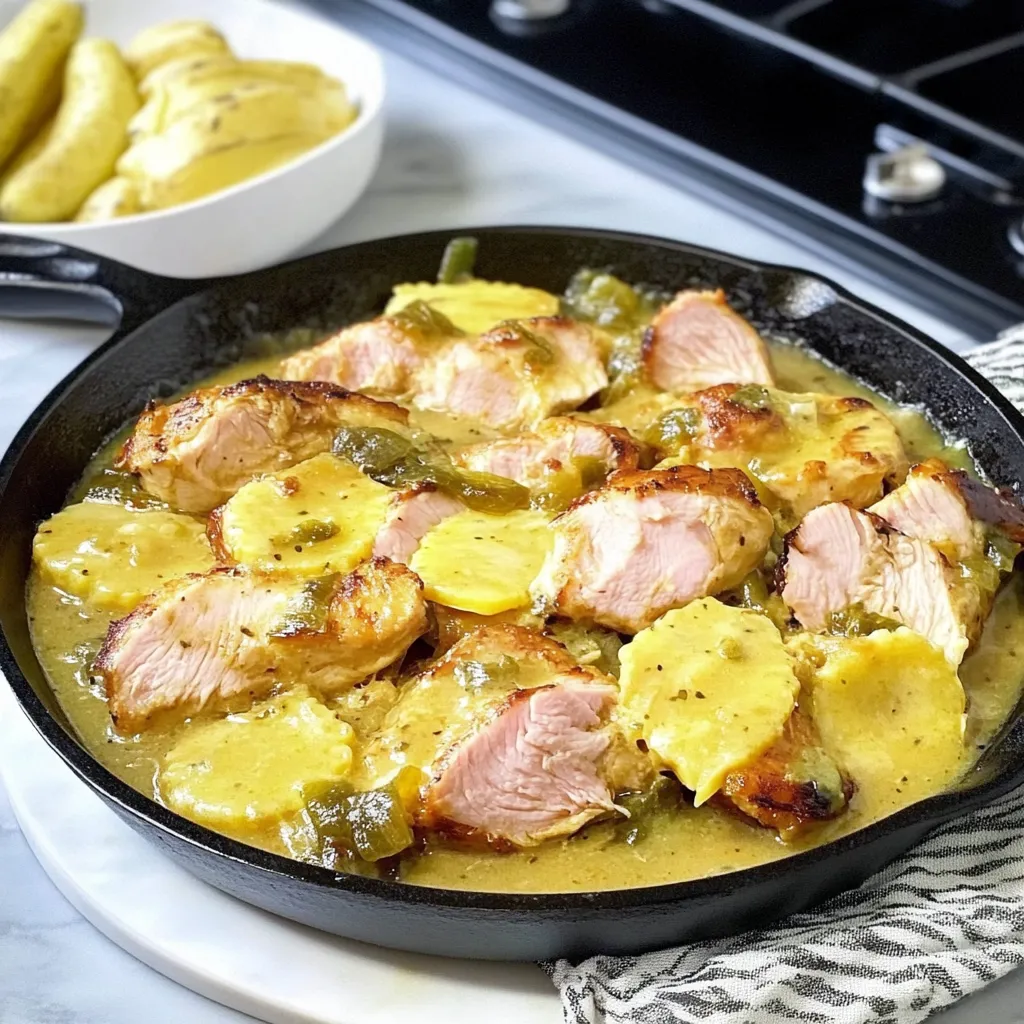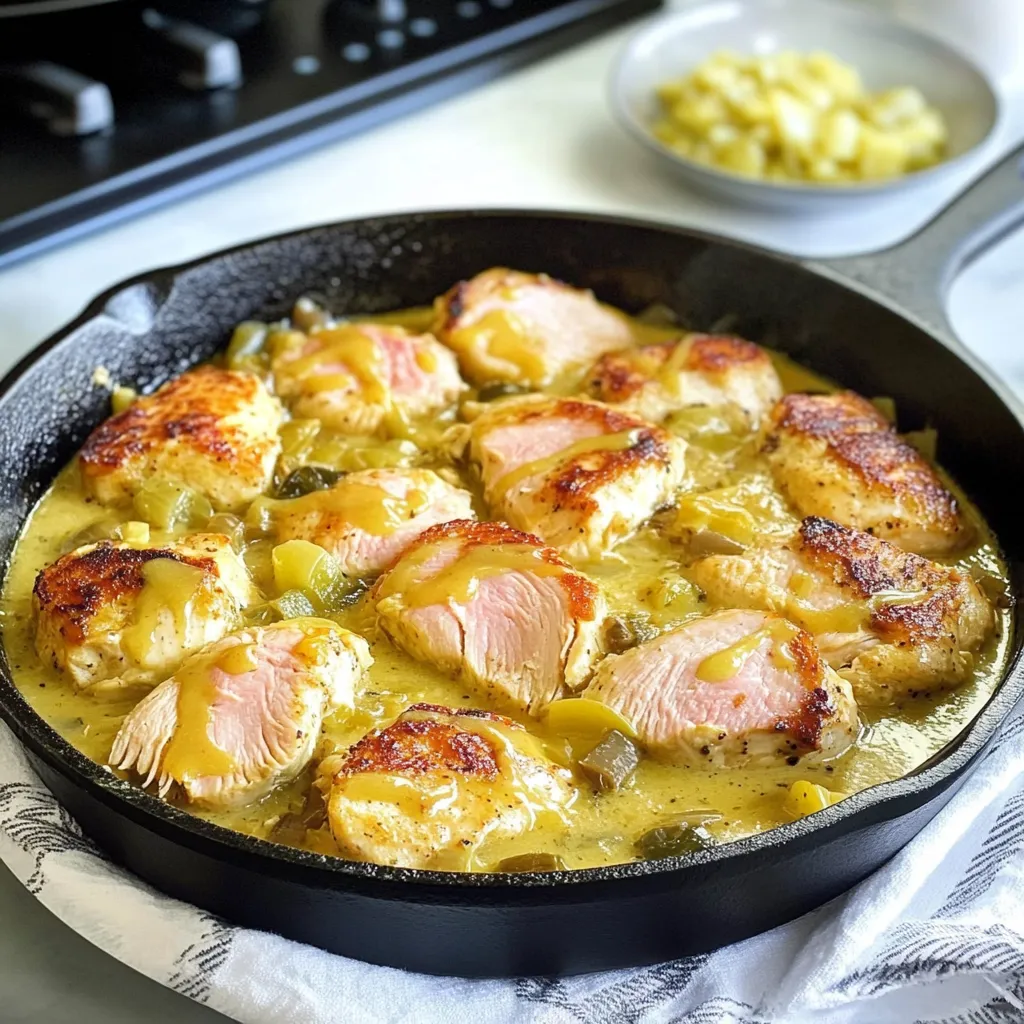Cast Iron Cuban Skillet: Perfect for Flavorful Dishes

There’s something undeniably magnetic about the sizzling, savory flavors that emerge from a cast iron pan, and when it comes to the Cast Iron Cuban Skillet, the experience is no exception. This dish is a delightful homage to the classic Cuban cuisine, melding vibrant spices, succulent proteins, and fresh vegetables, all cooked to perfection in one simple skillet. The beauty of this recipe lies not only in its rich, bold taste but also in its versatility. You can easily adapt the ingredients to suit your palate—swap in your favorite proteins or add seasonal veggies for a fresh twist.
For those aiming for culinary mastery, remember that preheating your skillet and allowing it to retain heat are crucial steps for optimal searing. A well-seasoned cast iron skillet enhances the dish, adding a depth of flavor that’s hard to replicate. Get ready to impress your friends and family with this stunning meal that brings the essence of Cuba right into your kitchen.
Ingredients for Cast Iron Cuban Skillet:
This delightful dish combines vibrant flavors, hearty ingredients, and a rustic cooking method that elevates your culinary experience. Below are the exact measurements for each ingredient needed to serve 8–10 people.
Proteins
- 2 lbs pork shoulder, cut into 1-inch cubes
- 1 lb chicken thighs, boneless and skinless, cut into bite-sized pieces
- 1 lb chorizo sausage, sliced into thick rounds
Vegetables
- 1 large onion, diced
- 3 cloves garlic, minced
- 1 bell pepper, preferably red or green, diced
- 1 cup diced tomatoes (canned or fresh)
- 2 cups green beans, trimmed and cut into 2-inch pieces
- 1 cup corn kernels (fresh, frozen, or canned, drained)
Spices and Seasonings
- 2 tbsp olive oil or vegetable oil for cooking
- 1 tbsp ground cumin
- 1 tbsp smoked paprika
- 1 tsp dried oregano
- 1 tsp salt (adjust to taste)
- 1/2 tsp freshly ground black pepper
- 1 tsp cayenne pepper (optional, for heat)
Rice and Broth
- 2 cups long-grain white rice, rinsed and drained
- 4 cups chicken or vegetable broth, low-sodium recommended
Garnishes
- 1/4 cup fresh cilantro or parsley, chopped (for garnish)
- 1 lime, cut into wedges (for serving)
Variations and Alternative Ingredients
To cater to different tastes, consider adding:
- 1 cup black beans for additional protein and fiber.
- Different types of sausage such as Italian or Andouille for added flavor complexity.
- Substituting quinoa for rice for a gluten-free option.
Feel free to adjust the spice levels by increasing or adding chili peppers based on your preference. The beauty of this dish lies in its versatility, allowing you to customize it to suit your palate!

How to prepare Cast Iron Cuban Skillet:
Creating a delicious Cast Iron Cuban Skillet requires attention to detail. Follow these clear steps to ensure a flavorful result.
Gather Your Ingredients
Start by collecting all the necessary ingredients. You will need:
- 1 lb of pork shoulder, cubed
- 1 large onion, sliced
- 3 cloves of garlic, minced
- 1 red bell pepper, chopped
- 1 green bell pepper, chopped
- 2 tsp cumin
- 2 tsp smoked paprika
- Salt and black pepper to taste
- 2 tbsp olive oil
- 1 lime, juiced
- Cooked rice for serving
Prepare the Pork
Begin by seasoning the pork with salt, black pepper, cumin, and smoked paprika. Ensure the pork is evenly coated.
Heat Your Cast Iron Skillet
Place your cast iron skillet over medium-high heat. Allow it to become hot before adding the oil.
Add Olive Oil
Pour 2 tablespoons of olive oil into the skillet. Swirl the oil around to coat the surface and prevent sticking.
Sear the Pork
Once the oil is shimmering, add the seasoned pork cubes. Sear them on all sides for about 5-7 minutes until browned.
Add Vegetables
Once the pork is browned, introduce the sliced onions and chopped bell peppers to the skillet. Stir well to combine.
Incorporate Garlic
Add the minced garlic to the mixture after the vegetables start to soften, about 3 minutes later. This will enhance the dish’s aroma.
Finish Cooking
Continue to cook the mixture, stirring occasionally, for an additional 10-15 minutes. Ensure the pork is cooked through and the vegetables are tender.
Finish with Lime Juice
Remove the skillet from heat and drizzle the lime juice over the entire dish. This adds zest and a refreshing touch.
Serve Your Dish
Serve the Cast Iron Cuban Skillet hot over a bed of cooked rice. Enjoy the vibrant flavors!
Tips for the Perfect Cast Iron Cuban Skillet
Creating a delicious Cast Iron Cuban Skillet dish requires attention to detail, quality ingredients, and proper techniques. Follow these tips to elevate your cooking experience.
Maintain the Correct Temperature
Cooking with cast iron can be tricky, especially when it comes to temperature control. Start by preheating your skillet on medium heat for 5-10 minutes. Before adding ingredients, carefully sprinkle a few drops of water. If they dance and evaporate quickly, your skillet is ready. Avoid cooking on high heat to prevent burning the ingredients. Instead, adjust the heat as necessary to maintain a consistent temperature while cooking your dish.
Use Quality Ingredients
Choosing the right ingredients makes a difference in flavor and texture. Fresh vegetables, high-quality meats, and fragrant spices all contribute to a successful dish. Visit a local farmer’s market for fresh produce or choose organic options when available. Additionally, opt for authentic Cuban flavors by selecting specific spices like cumin, oregano, and smoked paprika. These will enhance the aroma and taste of your skillet dish, making it more authentic and enjoyable.
Suitable Substitutions for Dietary Restrictions
If you or your guests have dietary restrictions, adapting your recipe can ensure everyone enjoys the meal. For a vegetarian option, replace meat with beans or lentils, providing that hearty texture. You can also use mushrooms or eggplant as a meat substitute, adding additional flavor and nutrients. If someone is gluten intolerant, verify that all spices and sauces are gluten-free or explore using coconut aminos as a soy sauce alternative. When adjusting ingredients, consider each flavor profile to keep your dish balanced and delicious.
Pro Tips for Serving
When serving, take advantage of the skillet’s presentation. Serve directly from the skillet for a rustic feel. Garnish with fresh herbs like cilantro or parsley for an extra pop of color and flavor. Pair your dish with Cuban bread or a fresh salad to complement the flavors. Encourage guests to warm the bread on the skillet’s edges for a delightful crispy bite.
By implementing these tips and techniques, you will create a mouthwatering dish that captures the essence of traditional Cuban cooking. Enjoy your culinary journey with these simple yet effective guidelines!
Storage Tips for Cast Iron Cuban Skillet:
A well-maintained cast iron skillet can last a lifetime, but proper storage is key to its longevity. Follow these tips for optimal storage conditions and to keep your cookware in fantastic shape.
Keep It Dry
Moisture is the enemy of cast iron. After each use, wash your skillet with warm water and mild soap (if necessary). Always dry it thoroughly right away. Avoid letting it air dry on the counter. Instead, place it on low heat for a few minutes to evaporate any remaining moisture.
Season Regularly
Regular seasoning helps maintain your skillet’s non-stick surface and prevents rust. After cleaning and drying, apply a thin layer of vegetable oil or flaxseed oil. Place the skillet upside down in a preheated oven to allow the oil to soak in. This practice ensures longevity and optimal cooking performance.
Store in a Cool, Dry Place
Store your cast iron skillet in a cool, dry location. Avoid placing it in damp areas, as moisture can lead to corrosion. Place it in a cupboard or kitchen cabinet rather than near the sink or stove, where steam can accumulate.
Use Paper Towels for Separation
If you stack your skillets, always place paper towels between them. This prevents scratches and keeps moisture at bay. The towels absorb any residual moisture and provide a barrier that encourages air circulation between the skillets.
Avoid the Oven for Long-Term Storage
While it may be convenient to store your skillet in the oven, it’s not ideal for long-term storage. Frequent heating may strip the seasoning, and forgetting it in the oven can lead to accidents or damage. Instead, find a safe cabinet that keeps it protected.
Limit Use of Plastic Wrap or Containers
Avoid wrapping your skillet in plastic wrap or storing it in plastic containers for prolonged periods. Such materials can trap moisture, leading to rust. Instead, opt for breathable cloth covers or simply leave it uncovered in a dry area.
Monitor for Rust
Regularly check your skillet for signs of rust. If detected, scrub it gently with a wire brush or fine steel wool, then re-season it immediately. Keeping an eye on its condition helps maintain its performance and extends its lifespan.
By following these practical storage tips, you can enjoy your cast iron skillet for years to come, ensuring it serves as a versatile cooking tool in your kitchen.
Related Recipes to Enhance Your Cast Iron Culinary Experience
Discovering complementary dishes can elevate your time in the kitchen. If you enjoyed the flavors and techniques found in this skillet dish, consider trying the following recipes.
First up is Spicy Garlic Shrimp. This dish features shrimp marinated in zesty spices, then quickly sautéed in a skillet. Its bold flavors pair wonderfully with the savory notes of the Cuban skillet, enhancing the overall meal. Serve this shrimp alongside rice or as a topping on a fresh salad for a refreshing twist.
Next is the Black Bean Salad, a vibrant and healthy option. The beans provide a rich texture and a delightful contrast to the Cuban skillet. This salad comes together with diced bell peppers, sweet corn, and a zesty lime dressing. It adds a refreshing element that balances the richness of the skillet, offering a lighter touch to your dining experience.
Lastly, consider preparing Mango Salsa. This sweet and tangy condiment brightens up any dish. Made from ripe mangoes, red onions, and cilantro, it bursts with flavor and freshness. Using it as a topping can enhance the taste profile of the Cuban skillet, bringing together the spicy and savory elements.
These recipes complement and elevate your meal, allowing for a delightful culinary journey that celebrates vibrant flavors and diverse textures. Each dish can stand alone but works harmoniously alongside the Cuban skillet, making them excellent choices to explore.
Frequently Asked Questions:
What is a Cast Iron Cuban Skillet used for?
A Cast Iron Cuban Skillet is a versatile cooking tool, ideal for a variety of dishes ranging from sautéing to frying. Its ability to retain heat makes it perfect for achieving that crispy exterior on meats, while also being great for simmering sauces or cooking vegetables. Additionally, this type of skillet is excellent for preparing traditional Cuban dishes like picadillo or ropa vieja, giving them an authentic flavor profile.
How do you properly season a Cast Iron Cuban Skillet?
Seasoning a Cast Iron Cuban Skillet is essential to maintain its non-stick surface and prevent rust. Start by cleaning the skillet thoroughly with hot water and a stiff brush. Then dry it completely before applying a thin layer of vegetable oil or a specialty cast iron conditioner. Place the skillet upside down in an oven preheated to around 375°F (190°C) and bake it for about an hour. Allow the skillet to cool in the oven before removing it. Regularly seasoning will ensure your skillet remains in peak condition.
Can you use metal utensils on a Cast Iron Cuban Skillet?
While it is possible to use metal utensils on a Cast Iron Cuban Skillet, caution is advised. Sharp metal tools can scrape off the seasoned coating if used excessively. To prolong the life of your skillet’s seasoning, it’s best to opt for wooden or silicone utensils whenever possible. This will help maintain the skillet’s non-stick properties and enhance its longevity.
Is a Cast Iron Cuban Skillet easy to clean?
Cleaning a Cast Iron Cuban Skillet can be straightforward if done correctly. Avoid using soap, as it can strip the seasoning. Instead, simply wipe it down with a paper towel or rinse it with warm water. For stubborn food residues, a gentle scrub with a brush or non-abrasive sponge is recommended. After cleaning, ensure to dry the skillet immediately and apply a thin layer of oil to keep it well-seasoned.
Can you cook acidic foods in a Cast Iron Cuban Skillet?
Cooking acidic foods, such as tomatoes or citrus-based dishes, in a Cast Iron Cuban Skillet is possible, but should be done cautiously. Prolonged exposure to acidic ingredients can break down the seasoning, which may lead to a metallic taste. If you plan to prepare acidic dishes, ensure your skillet is well-seasoned or consider using a different type of cookware for those specific recipes.
Why is a Cast Iron Cuban Skillet a good investment?
A Cast Iron Cuban Skillet is a worthwhile investment due to its durability and versatility. With proper care, it can last a lifetime, often passed down through generations. This type of cookware provides superior heat retention and distribution, which enhances cooking performance. Additionally, it adds a unique rustic charm to your kitchen and can be used on various cooking surfaces, including stovetops and ovens, making it an essential tool in any chef’s collection.
Conclusion:
The Cast Iron Cuban Skillet is a delightful representation of simplicity and versatility in the kitchen. With its straightforward preparation process, this dish invites both novice and seasoned cooks to experiment with traditional Cuban flavors. Emphasizing flexibility, you can easily customize ingredients to fit your taste preferences or use fresh produce available in your pantry. Unique tips, such as pre-heating the skillet and incorporating spices at different stages, truly elevate the dish, allowing for a richer taste experience. Remember, the charm of this recipe lies in its adaptability—feel free to swap proteins or add seasonal vegetables to make it your own. Enjoy the process of crafting your personalized version of this delightful meal, and relish the satisfying results that the Cast Iron Cuban Skillet offers, all while bringing a taste of Cuba right to your dining table. Happy cooking!
Print
Cast Iron Cuban Skillet: Perfect for Flavorful Dishes
- Total Time: 35 minutes
- Yield: 4 servings 1x
Description
A one-pan Cuban-inspired meal packed with savory flavors, tender meat, and vibrant veggies, all cooked to perfection in a cast iron skillet.
Ingredients
-
1 lb pork shoulder, sliced
-
1 tbsp olive oil
-
1 onion, sliced
-
1 bell pepper, sliced
-
3 cloves garlic, minced
-
1/4 cup fresh orange juice
-
2 tbsp lime juice
-
1 tsp cumin
-
1 tsp smoked paprika
-
Salt & pepper to taste
-
Fresh cilantro for garnish
Instructions
-
Heat olive oil in cast iron skillet over medium-high heat.
-
Cook pork slices until browned; set aside.
-
Sauté onion, bell pepper, and garlic until soft.
-
Return pork to skillet; add orange juice, lime juice, cumin, paprika, salt, and pepper.
-
Simmer 10 minutes until flavors meld.
-
Garnish with cilantro and serve.
Notes
-
Use fresh citrus juice for authentic flavor.
-
Serve with rice or black beans for a complete meal.
-
Leftovers reheat well and deepen in flavor.
- Prep Time: 10 minutes
- Cook Time: 25 minutes
Nutrition
- Calories: 350 kcal
- Fat: 18 g
- Carbohydrates: 8g
- Protein: 35g
